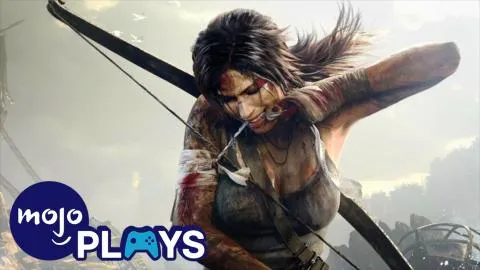Why Do They Beat The Shit Out of Lara Croft?

As the most famous female protagonist in video games, Lara Croft hasn’t been off our screens for long since 1996. There’s almost always a new installment of the “Tomb Raider” series just around the corner, but in 2013 it was officially reignited by Crystal Dynamics and ever since then Lara has definitely been put through the ringer. You can scarcely get through ten minutes of gameplay of the rebooted trilogy without something going horribly wrong, subjecting us – and Lara – to many brutal deaths and even more scripted injuries. But what is it about Lara that attracts pain and suffering more than almost any other lead character, especially in her newest appearances?
To begin, Lara’s many wounds could potentially be the result of the tonal shift the Square Enix reboots have taken. In the 1990s and 2000s, “Tomb Raider” was always a simple adventure game and Lara was a larger-than-life heroine, an expert archaeologist just going through the motions trying to find yet another lost artifact. But Crystal Dynamics have shifted the tone and genre from action-adventure to a more dark and realistic affair, keeping the adventure elements but adding in some horror elements and a focus on survival gameplay. As the games go on, they just get darker and darker, bloodier and bloodier, with “Shadow of the Tomb Raider” marking the darkest of the tree; a far-cry from the Lara Croft who lived on the PlayStation 1. With this darkness and the horror aspects taken into consideration, the excessive gore we witness makes a lot more sense when compared to “Tomb Raider’s” successor and rival, “Uncharted.” Of course, Nathan Drake gets injured as well – who could forget the gut shot in the train – but a wound like that, though knocking Nate out of commission for a good while in “Uncharted 2”, is something Lara Croft would probably just walk off. This happens because of the approach Crystal Dynamics are taking in trying to make “Tomb Raider” gritty and dark. Nathan Drake is charming. Lara Croft is a survivor.
However, the more you play of these gritty reboots, the more you’ll inevitably call into question their supposed “realism.” Not just because the games inevitably end with a supernatural twist, but because there’s no feasible way that Lara could survive nearly all the damage she takes. She nearly drowns, gets impaled, steps in a beartrap, and then drags her bloodied self through dirty corpse-water basically guaranteeing a deadly infection. It’s a trend that only continues, as she falls off a mountain in the opening of “Rise of the Tomb Raider”, and gets her leg trapped beneath a heavy rock in “Shadow,” only to wrap it with a few bandages and go on her merry way.
But Lara isn’t the only hero who gets pushed to her limits, this is a device used across all of fiction and for varying reasons. Primarily an injury to a character is used to evoke sympathy. From a storytelling standpoint, however, injuring characters – especially to the extent that Lara is injured – should be done sparingly or it loses all of its weight. Harming a character essentially needs narrative consequences. This why when Joel is impaled in “The Last of Us,” in a very similar injury to one Lara suffers, he is out of action and Ellie struggles to take care of them both. The entire crux of the next stage of the story is her getting antibiotics for Joel while he recovers. Meanwhile, Lara doesn’t seem too bothered by the very same injury.
Lara’s emotional trauma does, admittedly, serve to further her character development and hone her into a living weapon by “Shadow”, but physically she is never really any worse for wear, aside from minor changes to her character model. Yes, when she steps in the beartrap she is forced to limp and use a stick as a crutch, but this repercussion is active for barely ten minutes of the game until she miraculously heals and is back to her climbing, hunting ways. Injuring characters is a way to get the audience to care about them, to be invested in them, but how much do people really care about this iteration of Lara Croft who simply shakes off these punishing blows? It’s a fine line between actually wanting a character to live, and simply not wanting them to die. We’re never really worried that Lara will actually give up the ghost for good, and not just because of the promise of sequels. It’s just hard to care about a character who seems to be as durable and fast-healing as Wolverine or Deadpool.
Gore and violence also aren’t bad things in games. Games like “Dead Space” celebrate gore and vicious death animations, as Isaac Clark is one of the most brutalized characters around. But “Dead Space” is pure survival horror and is allowed to be, well, horrifying, while “Tomb Raider” – despite borrowing from the genre – is not fundamentally a horror game. Some of the death animations are brutal to the point of being horrific.
However, while she may not be a horror video game protagonist, she is still a video game protagonist. For all intents and purposes, Lara is almost a superhero, battling monstrous, otherworldly threats with little more than her wits and extreme durability. If Lara did die at every hurdle or injury or succumbed to infection or blood loss, nobody would want to play her games. With that said, though, across all three games she’s definitely taken enough beatings for three separate lifetimes, so maybe it’s time she gets some rest… until the next game of course!
Sign in
to access this feature